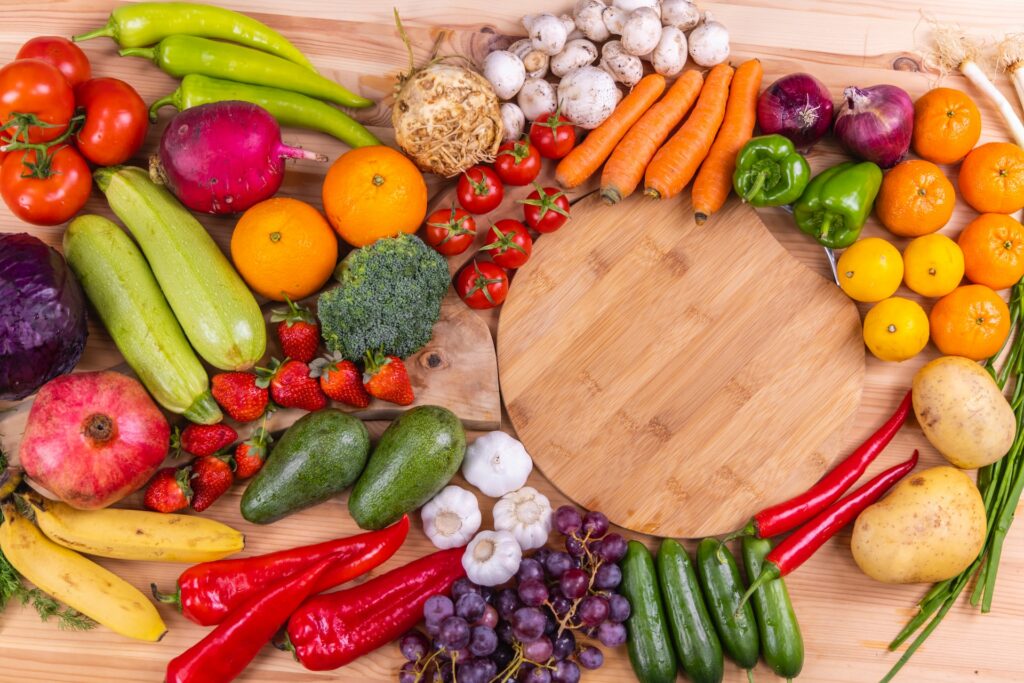Our supermarkets are changing. New fruits and vegetables are being added to the produce section to feed our adventurous appetite. The world is full of crazy-looking treats that make you look twice. Get a little bit adventurous and add one of these unusual fruits or vegetables to your daily routine.
Here are 55 crazy-looking fruits and vegetables you have to try!
Mexican Gherkins

Don’t be fooled by the exterior of these mini cucumbers; they are not melons. They are sweeter than the regular grocery store variety and have an audible crunch. Go ahead and pickle them for a cocktail party. Your guests are in for some confusion.
Dudhi

This vegetable, also known as calabash, is popular in Chinese stir-fry and North Indian curries. One type sold in China is called a “hairy squash.”
Long Beans

Long beans, or yard beans, are used as the traditional green bean, except they are a bit tougher. They are known for growing as long as three feet and are found in Malaysia, China, and the West Indies.
Kerala

This bumpy green squash is also known as bitter melon or bitter gourd. The flesh is laced with quinine, giving it its unique flavor. Before testing this out in a recipe, do some reading. It needs special treatment, like adding brown sugar to offset the bitterness.
Dragon Fruit

Though this fruit doesn’t look exactly like a dragon, its vibrant color is pretty extraordinary. When you cut them in half, they show a white fleshy interior that tastes kind of like kiwi. Don’t be afraid to try this one; you’ll be pleasantly surprised.
Jicama

Jicama is a tuberous root vegetable straight from Mexico. You have probably read it on the menu as part of a slaw. The jicama adds a crunchy texture but does not impart a lot of flavor. It makes a great addition to any salad.
Jackfruit

Don’t let this large fruit fool you. Though it is bigger than a watermelon, it does not taste like one. Some vegetarians use it as a meat substitute. Go ahead and search for a pulled “pork” recipe featuring this cousin of the mulberry. You won’t miss the meat at all.
Garlic Scapes

This green veggie is related to garlic, but it is a bit milder. Think of it as a blend between scallions and garlic. Next time you make pesto, mix in some garlic scapes for some zing.
Durian Fruit

By now, you have probably encountered the reputation of the durian fruit. Some say it is a blend of cheese, almonds, garlic, and caramel all in one. It is definitely an acquired taste. Most people unfamiliar with the fruit will turn away at their first whiff. If you’re feeling adventurous, this is one to try.
Loofah

You have seen this fruit in your local Bath and Body Works, but all dried up and ready for a massaging shower. When it is much younger, it tastes kind of like zucchini and is used in Indian cooking.
Lychee

This member of the soapberry family is native to Southeast Asia. It is tough to find lychee in its natural state unless it is late spring and you are wandering around Chinatown. Most of the time, it is found canned. Once the skin is peeled off, the white flesh has a floral scent. Go ahead and try it in your next martini. You’ll be in for a treat.
Radicchio Variegato di Castelfranco

No, there’s nothing wrong with this leaf vegetable. It is supposed to have spots. Just like the radicchio we know and love, it has a bitter taste. If you’re curious to try it, you’ll have to venture off to Venice, Italy, because it is not available in the United States.
Sea beans

Also known as Salicornia, Sea Beans are found in mangrove swamps in the United States and other random spots in the world. The plant likes to grow in salt water, which you can find them in tidewater areas. Try these steamed and coated with butter.
Manioc

This starchy tuber is also known as cassava or yuca. Commonly found in Caribbean cooking. Just like a potato, it is extremely versatile. You can boil it, marinate in garlic, vinegar, and olive oil, or eat it fried. Yuca fries are incredible when done right.
Dipper Gourd

Gourds are found in all shapes and sizes. This dipper gourd is no different. This exotic vegetable got its name from its hard exterior that can be cut and crafted to look like a ladle.
Snake Gourd

Another inconspicuous member of the gourd family made it onto this list. The snake gourd looks like its name. Don’t be surprised if you get a little frightened when you spot this harmless vegetable; they do look like snakes at first glance.
Winged Beans

These beans look like they are about to fly away. Their unique angled shape earned them the name of four-cornered beans or four-angled beans. Winged beans are extremely safe to eat. Most of its plant parts are edible.
Kohlrabi

The kohlrabi is related to cabbage and broccoli but sure doesn’t look like its cousins. The swollen stem part tastes a lot like broccoli and cauliflower and is prepared pretty much the same way.
Black Radish

Don’t be alarmed by this radish. The black skin and white flesh give a spooky contrast. Radishes do come in an array of colors, from white to red to orange. To give your dish a little color and contrast, add black radishes.
Moringa Fruit

The moringa fruit is making headlines for the health benefits found in its leaves. The fruit itself is used in many parts of the world and is prepared much like green beans.
Chayote

Similar tasting to butternut squash or pumpkin, the chayote is another member of the highly unusual-looking gourd family. This particular vegetable lacks seeds, and its pit is edible.
Miracle Fruit

This fruit is making its way to our grocery stores in pill form. It can make sour fruits like limes and lemons taste incredibly sweet. The miracle fruit contains a molecule called miraculin which distorts the shape of the sweetness receptors on the taste buds. If you’re looking for an interesting way to get your friends together, grab some miracle fruit pills and have them try limes. It is a conversation starter.
Banana Flower

Who knew the flowers on the banana tree were edible? We sure didn’t. They are a common vegetable in the tropics and are prepared much like artichokes.
Bamboo Shoots

Canned bamboo shoots are commonly found in grocery stores; some people have still tried this exotic vegetable. It does not have a distinct taste. Honestly, most people say it is bland. You could say the texture is like asparagus.
Belgian Endive

Want to spice up your next cocktail party? You can use bitter endives as an edible spoon for a shrimp salad. This vegetable is especially unusual because it grows underground to keep it from turning green and opening up. The whiter the color, the less bitter it tastes.
Achocha Fat Babies

Guess what? Another gourd. What is different about this vegetable is that it tastes like a cucumber when eaten young and raw, and it is a good substitute for green bell peppers when used for cooking. You’ll probably have better luck finding green peppers, but at least you know you have options.
Petch Siam Eggplant

This eggplant looks more like an unripe tomato. Before you start preparing to make fried green tomatoes, consider an eggplant parmesan instead. You won’t get the same acidic taste from this vegetable.
Black Carrots

Did you know that when carrots were originally cultivated, they were black or a deep shade of purple? So, in reality, orange carrots are the unusual ones. There is no difference in taste from their domestic counterparts. They do add color to your dish. What a great way to surprise your friends by telling them the purple on their plate is a carrot.
Romanesco

This unusual Italian vegetable looks more like it is straight out of an Atari game. Part of the broccoli family, it grows the same way but has a nuttier flavor.
Wooly Bear Gourd
Wait, this one can’t be a gourd? Well, this furry relative is tender and perfect for stir-frying. They grow best in the summertime, along with the rest of your veggies.
Purple Sweet Potato

Adding color to your garden is fun. First, we have black radishes, black carrots, and now purple sweet potatoes. The flesh of this tuber is yellow, red, or yellow.
Chioggia Beets

If you’re an avid ramen eater, you have probably seen this beet as a garnish. It is also known as a candy-striped beet for the alternating rings of dark red and white. The Chioggia guards mark beet is a great addition to any salad, soup, or plate, adding extra pizzazz and the recognizable beet flavor.
Rambutan

Also known as chom choms, rambutan is similar in texture and flavor to lychee. Don’t let the exterior alarm you; it is quite soft. All you have to do to get to the goodness inside is crack this baby in half and enjoy the soft and juicy interior.
Mangosteen

Tough on the outside but tangy and sweet on the inside, the funky-looking mangosteen is a fruit that takes a bit of work to get to the good stuff. This superfood has a laundry list of health benefits so go on and enjoy!
Longan

Another tropical fruit that looks like lychee, the longan, grows in grape-like clusters, which means you can have more than one at a time. Yum! You don’t get much fruit from the longan, but you’ll get to entertain your taste buds with a group of these.
Persimmon

The persimmon is another tomato imposter. Though the exterior looks a bit deceiving, the sweet and firm flesh is sure to please. You should expect it to taste a bit like dates.
Sapodilla

The exterior of this treat is pretty bland on the outside but packs a sugary punch with its sweet, orange interior. It tastes like a caramelized pear which means it’s perfect for dessert.
Starfruit

Also known as carambola in the Caribbean, this fruit looks exactly like a star when you cut it into slices. It’s a mix of citrus and apples, and the whole thing is edible.
Passion Fruit

This delicious tropical fruit is amazingly sweet and tart. It is easily made into desserts, smoothies, and so much more. Don’t overeat because passion fruit is known to drop your blood pressure.
Pomelo

The pomelo is basically a grapefruit on steroids. It is seven times bigger than its cousin. Once you get through the thick exterior, you will get to enjoy the tart interior, which is said to be better than the grapefruit.
Guava

The guava is a Caribbean staple that is considered a replacement for the apple. It is refreshing and is a great addition to any salad.
Kumquat

The kumquat is part of the citrus family, AND you can eat the peel. They are bite-sized and sweeter than an orange.
Tamarind

Much of Southeast Asian and Indian cuisine uses this tangy, sour, and sweet fruit. It’s a building block for our fave, pad thai. You can buy it fresh and soak it in water, or you can find the pre-made paste. It adds a little something extra to your dish.
Kiwano Melon

This prickly-looking melon is grown in Southern Africa, California, and New Zealand. The nickname “horned melon” is exactly what it looks like. The Kiwano has a citrus-like flavor, and the seeds are edible.
Sunchoke

Also known as Jerusalem artichokes, this root vegetable is extremely versatile. They make a great puree and do not have to be peeled.
Japanese Eggplant

The slender version of the eggplant emits a sweeter taste in recipes. They are less clunky than the Italian version and are great for stir-frying.
Celeriac

The celeriac was first mentioned in Homer’s Odyssey as selinon. This root vegetable tastes similar to the stalk of celery.
Jabuticaba

This fruit looks like a plum but tastes like a grape. The jabuticaba is uniquely grown in Brazil. Instead of growing on a vine-like fruit, this one grows directly on the trunk and branches.
Oca

This colorful root vegetable was originally cultivated in the Andes in South America. Also known as the “New Zealand Yam,” it became popular in the mid-1800s and is an excellent source of vitamin C, potassium, and iron.
Salsify

The salsify is related to the sunflower, but the root is edible. It has a history of being popular throughout Europe and is known to have medicinal qualities. Salsify was once believed to cure snake bites.
Nopales

If you thought this was cactus, you were right. The nopal comes from a particular kind of cactus that is edible once you peel the rough exterior. It is very popular in Mexico and makes a great vegetarian alternative to tacos.
Chinese Broccoli

Sometimes referred to as “Chinese broccoli” on menus in the United States, Kai-lan is a nutritious leafy green common in Cantonese cuisine. In fact, the hybrid vegetable broccolini is a cross between broccoli and kai-lan.
Dulse

Nori isn’t the only kind of seaweed we can enjoy. Enter dulse. It is common in the North Atlantic and known as “söl” in Iceland.
Fiddlehead

You might see these in Chopped mystery baskets. These residents of New England are not exactly exotic, but you do not find them often in our day-to-day cuisine. They are the furled fronds of a baby fern and are served boiled with butter.
Cherimoya

Also known as a “custard apple,” this funky heart-shaped fruit is native to South America. It tastes like a mix between pineapple and banana and was once described by Mark Twain as “deliciousness itself.”







